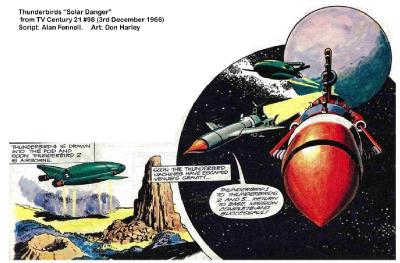Venusian Futures
Cytherean Dreams and Venusian Futures
Part Two: Venusian Futures
The imaginative landscapes envisaged for Earth’s sister planet - humanity’s Cytherean Dreams, as discussed in my last post - were becoming increasingly difficult to reconcile with scientific evidence at the dawn of the space age. By the mid twentieth century, little room for doubt remained regarding the hostility of Venus, and the number of writers exploring her surface declined. Nonetheless, a range of science fiction continued to explore Venusian futures.
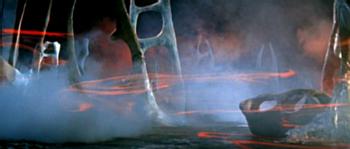 The 1960 Polish/East German film Der schweigende Stern (The Silent Star, dubbed and translated into English as First Spaceship on Venus, dir. Maetzig) was one of the earliest films to bring Venus into the modern era. Adapted from the novel The Astronauts by Stanislaw Lem (1951), it described an international mission to the planet. After passing through a turbulent atmosphere hundreds of kilometres thick, their ship reaches a hostile surface, blasted, blackened and vitrified, where the scientific investigators are forced to wear heavy space suits outside their ship. Gradually, the crew come to realise that Venus had once been inhabited (as they had believed before setting off), but that its native life had been wiped out by a great catastrophe of their own making [1]. The inhospitable, hostile environment was a sharp departure from more benign representations of the planet before that date, but was already in line with most scientific predictions.
The 1960 Polish/East German film Der schweigende Stern (The Silent Star, dubbed and translated into English as First Spaceship on Venus, dir. Maetzig) was one of the earliest films to bring Venus into the modern era. Adapted from the novel The Astronauts by Stanislaw Lem (1951), it described an international mission to the planet. After passing through a turbulent atmosphere hundreds of kilometres thick, their ship reaches a hostile surface, blasted, blackened and vitrified, where the scientific investigators are forced to wear heavy space suits outside their ship. Gradually, the crew come to realise that Venus had once been inhabited (as they had believed before setting off), but that its native life had been wiped out by a great catastrophe of their own making [1]. The inhospitable, hostile environment was a sharp departure from more benign representations of the planet before that date, but was already in line with most scientific predictions.
The first space probe to successfully flyby Venus (i.e. pass close to the planet without stopping) was Mariner 1 in 1962, while the first successful mission to descend into the Venusian atmosphere was Venera 4 in 1967. In quick succession, Mariner 5, Venera 5 and Venera 6 relayed information about Venusian conditions, before Venera 7 achieved the first landing in December 1970, reporting surface temperatures exceeding 470 degrees centigrade (900 F) and pressures of more than 90 Earth atmospheres (close to the current best estimates).
Facing the Inferno
There is some evidence that writers (both scientific and science-fictional) in the 1960s were initially reluctant to surrender their rich imaginary of Venus as a potentially habitable world. For instance, in the opening episode of the 1961 children’s science fiction television drama series Pathfinders to Venus, and in keeping with the educational remit of the series, the juvenile characters discuss the planet’s thick cloud, carbon dioxide rich atmosphere and lack of oxygen in observations (all known since the 1920s or earlier), but the story nonetheless stresses the mysterious surface under the cloud cover and goes on to repeat the outdated imagery of prehistoric Venus.
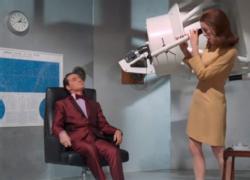 In some cases, the representation of Venus is definitely tongue in cheek. In the British television series The Avengers, for instance, a 1967 episode “From Venus with Love” featured members of the British Venusian Society (a group of amateur astronomers and enthusiasts strongly reminiscent of the real-world British Interplanetary Society) who are struck dead in the process of watching the planet, hinting at a rather unlikely imminent invasion. As with many characters in this era of The Avengers, the group members are an eccentric bunch, many of whom believe in life on the planet. Even so, there’s acknowledgement of the uncertainty. A member of the society tells protagonist Steed (and the audience) that “If there’s life up there, it’s not life as we know it. It’s hot up there. Very hot.”
In some cases, the representation of Venus is definitely tongue in cheek. In the British television series The Avengers, for instance, a 1967 episode “From Venus with Love” featured members of the British Venusian Society (a group of amateur astronomers and enthusiasts strongly reminiscent of the real-world British Interplanetary Society) who are struck dead in the process of watching the planet, hinting at a rather unlikely imminent invasion. As with many characters in this era of The Avengers, the group members are an eccentric bunch, many of whom believe in life on the planet. Even so, there’s acknowledgement of the uncertainty. A member of the society tells protagonist Steed (and the audience) that “If there’s life up there, it’s not life as we know it. It’s hot up there. Very hot.”
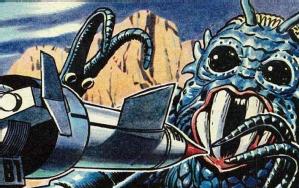 Another interesting example of the Venera-era ambivalence can be found in the 1966 comic adventure Thunderbirds: Solar Danger, which appeared in the comic TV Century 21 (numbers 83-98). Written by Alan Fennell and illustrated by Frank Bellamy and Don Hartley, the story (aka Destination Sun, originally untitled) started with the premise that the Sun had become unstable and is about to eject a new planet, disrupting the Solar System. Despatched to solve the problem, rocket ship Thunderbird Three does so, but then crash-lands on Venus, forcing the usually Earthbound Thunderbirds One and Two to be modified for spaceflight and sent to the rescue. On reaching Venus, the characters face sulphur lakes and monstrous, hostile alien creatures which threaten to destroy their craft.
Another interesting example of the Venera-era ambivalence can be found in the 1966 comic adventure Thunderbirds: Solar Danger, which appeared in the comic TV Century 21 (numbers 83-98). Written by Alan Fennell and illustrated by Frank Bellamy and Don Hartley, the story (aka Destination Sun, originally untitled) started with the premise that the Sun had become unstable and is about to eject a new planet, disrupting the Solar System. Despatched to solve the problem, rocket ship Thunderbird Three does so, but then crash-lands on Venus, forcing the usually Earthbound Thunderbirds One and Two to be modified for spaceflight and sent to the rescue. On reaching Venus, the characters face sulphur lakes and monstrous, hostile alien creatures which threaten to destroy their craft.
This story is an interesting throwback in several respects. The idea that planets were formed from the same material as the Sun, either pulled away by a passing body or splitting off from the Sun early during its formation, was widely considered in scientific circles in the early 1900s but by the 1960s had largely been superceded by the now-current models of planet formation in a debris disk around the young Sun. On the other hand, it’s interesting to note that self-taught cosmologist Louis Jacot appears to have been popularising a solar fission concept - in contradiction to mainstream canonical ideas and ignoring extensive evidence - around 1962, and that a similar idea appears in Hugh Walters' juvenile novel Destination Mars in 1963.
When the Thunderbird craft reach Venus, aspects of the representation are clearly influenced by the probe findings - Venus’s dense atmosphere is an important plot point, blocking communications. Mountains and much of the landscape shown are barren and devoid of life, bare rock peaking through mist. The personnel of International Rescue have to wear anti-chemical space suits, unable to breathe in Venus’s atmosphere. And Thunderbird Three crashes into a corrosive lake of molten sulphur, suggesting a high surface temperature - sulphur is a solid at room temperature and melts at about 120 degrees centigrade (248 oF).
On the other hand, there are aspects of the representation that hark back to far older visions of Venus. One of the character, Brains, has to be rescued from a carnivorous plant in a setting much like the Cytherean jungles of earlier representations. Monstrous life is also abundant in the sulphur lakes, providing submerged scenes which echo the water-worlds of Venus past. And while the characters are apparently protected by suits, there is no mention of the true surface temperatures of Venus - able to melt most metals - or of the crushing weight of atmospheric pressure any such astronauts would experience. Overall the story suggests a generation of writers who grew up with visions of habitable Venus and were reluctant to surrender such visions in the face of the evidence of the Mariner and Venera probes.
A more realistic view of Venus from this era can be found in Arthur C Clarke’s short story “Before Eden” (Amazing Stories, 1961). Clarke was a keen member of the British Interplanetary Society and careful to stay abreast of scientific developments. His story focuses on early human explorers on Venus. These encounter a very hot environment, but as the crew head towards the mountains at the south Venusian pole, they find that the temperature at altitude drops towards the boiling point of water, at which extremophile life is possible on Earth (for example, in boiling thermal springs). As one notes:
“Where there's water, there may be life. We’ve been in too much of a hurry to assume that Venus is sterile, merely because the average temperature’s over five hundred degrees. It’s a lot colder here, and that’s why I’ve been so anxious to get to the Pole. There are lakes up here in the highlands, and I want to look at them.”
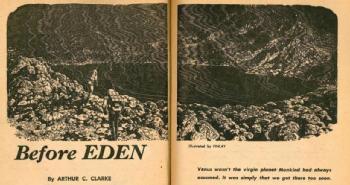
Clarke notes the underwater-like visual distortions caused by the thick atmosphere, the need for thermal insulation suits and oxygen supplies, and the slightly lower gravity of Venus compared to Earth, but does not comment on the extreme atmospheric pressure, which would crush any human to the ground. His explorers do indeed discover signs of extreme life - although, in an early object lesson for planetary protection arguments, they may well be the last to do so.
Author Larry Niven also confronted the full temperature and pressure of Venus in his short story "Becalmed in Hell" (1965). Here an exploration ship designed to float twenty miles above the surface encounters a technical problem and is forced to land on the surface to make repairs. As we're told, they find a:
"Searing black calm."
"Right."
"Someone dreamed up that phrase when I was a kid, just after the news of the Mariner II probe. An eternal searing black calm, hot as a kiln, under an atmosphere thick enough to keep any light or breath of wind from ever reaching the surface."
Another among the early authors to confront Venus in its full post-Venera hostility was John Varley when he included Venus in his Eight Worlds series of stories, which started with The Ophiuchi Hotline. In this timeline, humanity has been driven off Earth by aliens, and inhabit a range of artificial environments elsewhere in the Solar System. The novellette “In The Bowl” (Fantasy & SF, Dec 1975, collected in The Persistence of Vision, 1978) took its main character to Venus. As with many of the 1950s and 60s stories the protagonist’s main goal is collection of precious minerals, in this case explosive blast jewels in the Fahrenheit Desert.
In the opening few paragraphs, Varley’s narrator character baits and switches preconceptions about the planet, commenting on Venusburg’s “prehistoric monsters that wallow in the fetid marshes” and then immediately on “after hours - when they turn all the holos off and the place reverts to an ordinary cluster of silvery domes sitting in darkness and eight-hundred-degree temperature and pressure enough to give you a sinus headache just thinking about it, when they shut off all the tourist razzle-dazzle”. Indeed we later hear about rivers of molten aluminium and the way the atmosphere distorts the light of the Sun, providing the illusion of living in a bowl, and giving the story its title.
The narratives in this series are set several centuries after the establishment of the off-world settlements, and assume a technology that extends to elective surgical organ replacement (including sex-changed body exchanges), personality recordings and plenty of other equipment well beyond our current engineering level. In the context of “In the Bowl”, the surgical replacements include a “Venus-Lung” which provides five-days of survival potential, and a “Gloom Piercer” artificial eye which uses infrared so that
“your right eye, the one that sees what’s called visible light - shows you only a small circle of light that’s illuminated by your hand torch. Occasionally there’s a glowing spot of molten metal in the distance, but it’s far too dim to see by. Your infraeye pierces those shadows and gives you a blurry picture of what lies outside the torchlight, but I would have almost rather been blind.”
However the single most important technology in the Venus of “In the Bowl” is the existence of pressure- and temperature-resistant null fields which allow humans both to build and to explore the hostile world. Needless to say, these lie beyond the implementation of any plausible scientific principles currently known.
Terraforming Venus
Once both writers and the SF audience accepted the fundamental hostility of the Venusian surface, attention turned in a different direction: might Venus be made habitable for humanity?
The Japanese manga comic Venus Wars (1986-1990) written by Yoshikazu Yasuhiko, and its associated anime film (1989, dir. Yasuhiko) is set about eighty years after a giant ice asteroid strikes Venus. The impact simultaneously burns off a large amount of Venusian atmosphere, speeds up its rotation and delivers a great quantity of water to the planet. This starts a natural terraforming (i.e.”making like earth”) process which is then further advanced by human intervention. By the epoch of the narrative, the planet hosts acidic oceans, an atmosphere that is breathable with minimal protection and several million people living amidst dust storms. While a cosmic impact of this kind is unlikely in the extreme at this stage of the Solar System’s evolution, it’s not impossible and could indeed have the effect envisaged. Indeed crashing ice asteroids or comets into Mars has been proposed as a viable terraforming method in the less extreme conditions there [2]. Above all, it resolves the problem of removing large amounts of material from the Venusian atmosphere: a necessary prerequisite of most terraforming proposals.
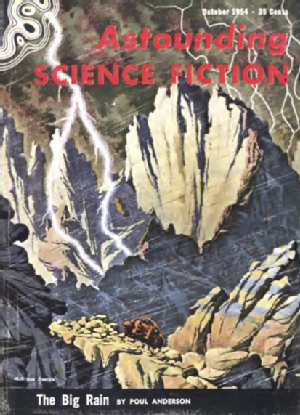 However others have suggested that Venus might be terraformed even without such an enormous natural kick-start to the process. Perhaps the most influential early suggestion was offered by author Poul Anderson in his novella “The Big Rain” (Astounding, Oct 1954). Anderson’s Venus is very clearly a scientifically-inspired inferno:
However others have suggested that Venus might be terraformed even without such an enormous natural kick-start to the process. Perhaps the most influential early suggestion was offered by author Poul Anderson in his novella “The Big Rain” (Astounding, Oct 1954). Anderson’s Venus is very clearly a scientifically-inspired inferno:
”The city crouched on a mountainside in a blast of eternal wind. Overhead roiled the poisonous gray clouds; sometimes a sleet of paraformaldehyde hid the grim red slopes around, and always the scudding dust veiled men’s eyes so they could not see the alkali desert below.”
Even here though, the pre-Venera state-of-the-art underestimated the conditions at the surface. While Anderson describes high winds and mechanisms for controlling the temperature and the toxic atmosphere, he describes the surface merely as being at the boiling point of water and doesn’t address the intense surface pressure.
In this story Venus has been settled by the remnants of long-depleted mining settlements which have broken away from Earth control. But they dream of a better future, one which they will manufacture by modifying the atmosphere:
“Paraform was broken down and yielded its binding water molecules; the formaldehyde, together with that taken directly from the air, reacted with ammonia and methane - or with itself - to produce a whole series of hydrocarbons, carbohydrates, and more complex compounds for food, fuel and fertilizer; such carbon dioxide as did not enter other reactions was broken down by sheer brute force in an arc to oxygen and soot.”
In theory seven million machines driving this reaction, together with triggered volcanic activity, would result in a decade of rainfall, the titular Big Rain, after which Venus would have a breathable atmosphere and allow humans to survive unprotected.
While the original reaction proposed by Poul Anderson would likely be unsuccessful, given the high pressures, temperatures and atmospheric composition now known on Venus’s surface, other suggestions for triggered chemical reactions have included the use of both graphite and other carbonates of elements like magnesium or calcium to lock up carbon dioxide. Others, including Carl Sagan in a landmark article published in Science in 1961, have suggested the use of bio-organisms designed to break down carbon dioxide - although again most proposals would not work in the extreme conditions. The largest issue is presented by the sheer thickness of the Venusian carbon dioxide rich atmosphere, and the amount of material comprising it. Any attempt to extract its carbon might release oxygen but would also result in several hundred tonnes of graphite per square metre, forming a thick layer across the entire surface. This graphite would instantly burn in the oxygen at the surface pressures that would result, releasing more carbon dioxide.
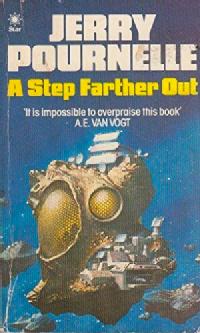 Another science fiction writer (and NASA engineer), Jerry Pournelle wrote an essay on terraforming Venus and the Big Rain in 1975 for his A Step Further Out column for Galaxy Science Fiction magazine (these columns were later compiled in a book of the same name). He commented that
Another science fiction writer (and NASA engineer), Jerry Pournelle wrote an essay on terraforming Venus and the Big Rain in 1975 for his A Step Further Out column for Galaxy Science Fiction magazine (these columns were later compiled in a book of the same name). He commented that
“It’s not a very attractive place to live. In fact, a more useless planet is hard to imagine. What good is a lump of desert whose surface temperature is up there about the melting point of lead, whose atmosphere is too thick, with winds of fearful velocity and force blowing dust across craters and jumbled structures like the surface of the Moon?”
Despite that, he confidently asserts that
“Not only can we terraform Venus, but we could probably get the job done in this century, using present-day technology. The whole cost is unlikely to be greater than a medium-sized war, and the pay-off is enormous: a whole New World, a frontier to absorb adventurers and the discontented.”
In Pournelle’s view, this will be accomplished by the widespread deployment of blue-green algae into the upper atmosphere as reducers of carbon dioxide in what he describes as “Project Morning Star”, and which he expects could be achieved within twenty years. In this he is echoing Sagan’s 1961 article and also references the novella “To Build a World” (published in Galaxy in 1964) by Poul Anderson expanding on his views. Interestingly, Pournelle also comments on the possibility of hypothetical Venusian life, noting that this will be driven to extinction, but arguing that this would be justified. As with the chemical reaction, the approach suggested here does not remove the difficulties of the depth and pressure of the atmosphere or dealing with any carbon or other materials precipitated from it, although this would not be widely recognised for two decades after Pournelle’s optimistic comments.
Nonetheless, science fictions continue to assume that terraforming Venus, while beyond our capabilities, is possible. Amongst more recent examples are elements of the Star Trek universe, in which Venus is being actively terraformed in the twenty-fourth century. Time-travelling crew from Star Trek: Deep Space Nine commented on the lack of terraforming activity on Venus when sent to the past in the two-part story “Past Tense” (1995). The process was explored in more detail in a novella in the Starfleet Corps of Engineers (SCE) series. In “Ishtar Rising” (Mangels, 2003), the titular corps - and in particular one of their number who is highly skilled with computing - are recruited to assist when a crucial stage of the terraforming hits trouble. Here Project Ishtar (named for the Babylonian deity associated with the both the planet and goddess Venus) aims to trigger and control a massive magma expulsion from Venus, creating a ring system that will ultimately coalesce into a Venusian moon.
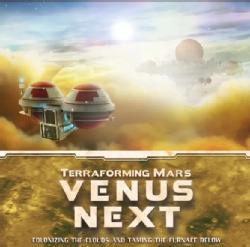 It’s fair to say that such technologies are hard to imagine. More practical and perhaps realistic (although still far beyond our current capabilities) have been discussed in a perhaps unlikely setting: The board game Terraforming Mars (created by Jacob Fryxelius in 2016) released an expansion in 2017 entitled Venus Next. The main game focuses on deploying hypothetical technologies to modify the global conditions on Mars, raising the temperature, the oxygen concentration and the number of oceans. The Venus Next expansion recognises that terraforming Venus will take much longer than Mars, and sets a target of completing only 30% of the required process by the end of the game. The technologies here are less detailed than those described for use on Mars, but include floating technologies, deliberate asteroid impacts to increase Venus’s spin, an equatorial magnetiser to increase her magnetic field, orbital sunshields to reduce the temperature, and microbes to modify the atmospheric composition.
It’s fair to say that such technologies are hard to imagine. More practical and perhaps realistic (although still far beyond our current capabilities) have been discussed in a perhaps unlikely setting: The board game Terraforming Mars (created by Jacob Fryxelius in 2016) released an expansion in 2017 entitled Venus Next. The main game focuses on deploying hypothetical technologies to modify the global conditions on Mars, raising the temperature, the oxygen concentration and the number of oceans. The Venus Next expansion recognises that terraforming Venus will take much longer than Mars, and sets a target of completing only 30% of the required process by the end of the game. The technologies here are less detailed than those described for use on Mars, but include floating technologies, deliberate asteroid impacts to increase Venus’s spin, an equatorial magnetiser to increase her magnetic field, orbital sunshields to reduce the temperature, and microbes to modify the atmospheric composition.
A Life in the Clouds
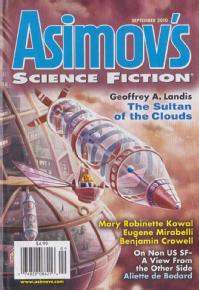 In recent years, a new possibility for human life on Venus has come to public attention. Published in 2010 in Asimov’s Science Fiction magazine, Geoffrey Landis’s novella The Sultan of the Clouds describes a future in which large cities are suspended in the Venusian cloud layer:
In recent years, a new possibility for human life on Venus has come to public attention. Published in 2010 in Asimov’s Science Fiction magazine, Geoffrey Landis’s novella The Sultan of the Clouds describes a future in which large cities are suspended in the Venusian cloud layer:
“The city was a dome, or rather, a dozen glistening domes melted haphazardly together, each one faceted with a million panels of glass. The domes were huge; the smallest nearly a kilometer across, and as the barque glided across the sky the facets caught the sunlight and sparkled with reflected light. Below the domes, a slender pencil of rough black stretched down toward the cloud-base like taffy, delicate as spun glass, terminating in an absurdly tiny bulb of rock that seemed far too small to counterbalance the domes.”
In these domes, carbon (most often in the form of diamond) is a lightweight and readily-obtained construction material:
“Geodetic structures with struts of sintered graphite and skin of transparent polycarbonate synthesized from the atmosphere of Venus itself, each kilometer-diameter dome easily lifted a hundred thousand tons of city.”
Landis is a NASA engineer as well as a prize-winning writer of SF, and has written scientific factual articles on the colonization of Venus. As his 2003 paper on the topic notes, the environment above the clouds on Venus is actually the closest match to the surface of Earth that can be found in the Solar System. At around 50 kilometres above the surface, the atmospheric pressure is close to that of Earth, gravity is 90% of Earth-normal, the temperature permits liquid water and solar energy can be used. A volume filled with human-breathable air (at about 80% nitrogen, 20% oxygen) would itself be buoyant at this altitude in the Venusian atmosphere.
Even at the 50 km altitude level, humans on Venus would need to be protected from the atmosphere itself (which at this altitude contains abundant sulphuric-acid droplets), and would need an oxygen supply (difficult to obtain on Venus) as well as resources mined from the ground (by remote machines), but, as Landis argued, self-sustaining floating cities may be entirely practicable. This is reflected in the narrative of his The Sultan of the Clouds, which describes more than ten thousand such habitats and imagines most of Venus as the hegemony of a spoilt child. Unfortunately, the young sultan’s ideas for pursuing terraforming could have catastrophic consequences.
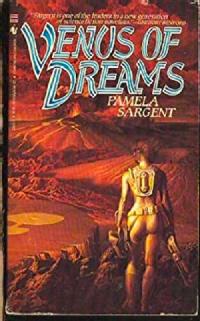 Landis’s proposals built on many decades of experimentation and design for both robotic and human scientific exploration of Venus. Indeed, the soviet Vega probes had demonstrated balloon-supported flight in the atmosphere of the planet almost two decades before, in 1985. These early successes may have formed part of the inspiration for an earlier, albeit less technical, narrative involving floating Venusian cities. Pamela Sargent’s Venus Trilogy (Venus of Dreams, 1986; Venus of Shadows, 1989; Child of Venus, 2001) follows the efforts of the scientist protagonist, Iris Angharad, and her descendants, to terraform Venus. However, well before the surface conditions are tolerable, the human inhabitants of the planet occupy floating “islands” suspended high in the atmosphere. These also build on a long tradition in SF of floating habitats in the upper atmospheres of exoplanets - particularly gas giants, as seen for example in the Bespin Cloud City in Star Wars: The Empire Strikes Back (1980).
Landis’s proposals built on many decades of experimentation and design for both robotic and human scientific exploration of Venus. Indeed, the soviet Vega probes had demonstrated balloon-supported flight in the atmosphere of the planet almost two decades before, in 1985. These early successes may have formed part of the inspiration for an earlier, albeit less technical, narrative involving floating Venusian cities. Pamela Sargent’s Venus Trilogy (Venus of Dreams, 1986; Venus of Shadows, 1989; Child of Venus, 2001) follows the efforts of the scientist protagonist, Iris Angharad, and her descendants, to terraform Venus. However, well before the surface conditions are tolerable, the human inhabitants of the planet occupy floating “islands” suspended high in the atmosphere. These also build on a long tradition in SF of floating habitats in the upper atmospheres of exoplanets - particularly gas giants, as seen for example in the Bespin Cloud City in Star Wars: The Empire Strikes Back (1980).
The idea of floating cities on Venus has now become part of the cultural mainstream, with examples including The Quiet Invasion (novel, Sarah Zettel, 2000, in which Venera base is a floating sphere), Saturn’s Children (novel, Charles Stross, 2008, in which the floating cities are occupied by the android inheritors of long-extinct humanity), the 2012 Doctor Who audio adventure "Voyage to Venus" (in which a floating city is named Amtor in an echo of the planetary romances of Edgar Rice Burroughs), Terraforming Mars: Venus Next (board game, 2017), and the 2016 audio adaptation of Dan Dare: Pilot of the Future (in which the cities are occupied by reptilian Treens rather than humans). Indeed, NASA’s “Visions of the Future” (a series of tourist-style posters promoting the key features of various worlds and exoworlds) features a cloud city to represent Venus, with the tagline “see you at the cloud 9 observatory” (NASA/JPL, 2020).
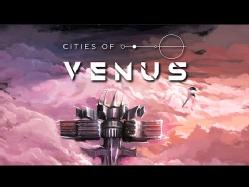 Scheduled for release in 2024 is another board game, this time from Tin Robot Games and actually entitled Cities of Venus, in which the entire premise pivots around floating human habitats in the upper atmosphere. These are struggling to become self-sufficient when contact with Earth is cut off unexpectedly. Indeed, the project invoked the use of narrative science fiction as a promotional tool, with six chapters of “Cities of Venus Chronicles” released during the promotional campaign, each expanding on the basic premise (while dramatising features and events in the game itself). The success of this board game project on the kickstarter platform (where it exceeded its target funding goal by a factor of seven) speaks to the popularity of the idea and the hold it has on contemporary science fictional imaginations.
Scheduled for release in 2024 is another board game, this time from Tin Robot Games and actually entitled Cities of Venus, in which the entire premise pivots around floating human habitats in the upper atmosphere. These are struggling to become self-sufficient when contact with Earth is cut off unexpectedly. Indeed, the project invoked the use of narrative science fiction as a promotional tool, with six chapters of “Cities of Venus Chronicles” released during the promotional campaign, each expanding on the basic premise (while dramatising features and events in the game itself). The success of this board game project on the kickstarter platform (where it exceeded its target funding goal by a factor of seven) speaks to the popularity of the idea and the hold it has on contemporary science fictional imaginations.
The identification of the chemical phosphine (PH3) in the atmosphere of Venus announced by a team led by Prof. Jane Greaves in 2021 (initially disputed and more recently reconfirmed, in evidence of a healthy scientific debate on the topic) has re-ignited interest in our sister planet. Indicative of non-equilibrium (unstable) chemistry, it could be a sign of some form of life (or of hitherto-unknown chemical processes) on the planet. A number of space probe missions have now been selected for development and deployment over the coming decade or more, including mapping, atmospheric analysis and lander instruments. Of these Shukrayaan-1 and Venera-D will carry balloon payloads, giving us still more insight into the viability of lighter-than-Venusian-air habitats.
Of course, the vast majority of us will never visit Venus. Perhaps then, there is little harm in adopting the approach of S M Stirling in his 2008 novel The Sky People or George R R Martin and Gardner Dozois in their 2015 anthology Old Venus. These affectionate pastiches of the planetary romance genre people Venus once more with jungles, dinosaurs and prehistoric man. They reflect on the era when the Solar System appeared rich in opportunities and our future lay in the stars. While such Cytherean dreams are now firmly consigned to the realms of fantasy, they remain a window into the aspirations of humanity and the connection felt by many to our neighbour worlds.
“Venusian Futures”, Elizabeth Stanway, Cosmic Stories blog, 14th January 2024.
Notes:
[1] “First Spaceship on Venus” is also noteworthy for including video images of what I think may be the very early Fort Skala radio telescope belonging to Jagiellonian University in Poland. [Return to text]
[2] Note that in the Expanse universe (novels and TV series, 2015-present) there are hints that crashing Eros into Venus might start a similar process but reality would require many thousands of such impacts. [Return to text]
Opinions and views expressed in this blog are those of the author, and not necessarily those of the University of Warwick. Images sourced on public websites online and used here for commentary.

